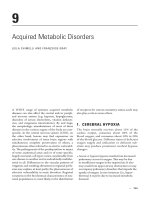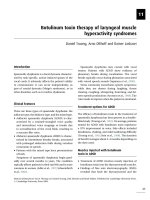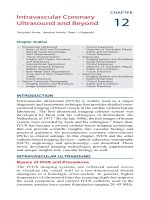Ebook Manual of otologic surgery: Part 1
Bạn đang xem bản rút gọn của tài liệu. Xem và tải ngay bản đầy đủ của tài liệu tại đây (2.19 MB, 36 trang )
Manual of
Otologic Surgery
Christoph Arnoldner
Vincent Y.W. Lin
Joseph M. Chen
123
Manual of Otologic Surgery
Christoph Arnoldner • Vincent Y.W. Lin
Joseph M. Chen
Manual of Otologic
Surgery
Christoph Arnoldner
Department of Otorhinolaryngology
Medical University of Vienna
Vienna
Austria
Joseph M. Chen
Department of Otolaryngology
Head & Neck Surgery
Sunnybrook Health Sciences Center
Toronto, Ontario
Canada
Vincent Y.W. Lin
Department of Otolaryngology
Head & Neck Surgery
Sunnybrook Health Sciences Center
Toronto, Ontario
Canada
Videos to this book can be accessed at
/>ISBN 978-3-7091-1489-6
ISBN 978-3-7091-1490-2
DOI 10.1007/978-3-7091-1490-2
Springer Wien Heidelberg New York Dordrecht London
(eBook)
Library of Congress Control Number: 2014957315
© Springer-Verlag Wien 2015
This work is subject to copyright. All rights are reserved by the Publisher, whether the whole or part of
the material is concerned, specifically the rights of translation, reprinting, reuse of illustrations, recitation, broadcasting, reproduction on microfilms or in any other physical way, and transmission or information storage and retrieval, electronic adaptation, computer software, or by similar or dissimilar
methodology now known or hereafter developed. Exempted from this legal reservation are brief excerpts
in connection with reviews or scholarly analysis or material supplied specifically for the purpose of being
entered and executed on a computer system, for exclusive use by the purchaser of the work. Duplication
of this publication or parts thereof is permitted only under the provisions of the Copyright Law of the
Publisher’s location, in its current version, and permission for use must always be obtained from Springer.
Permissions for use may be obtained through RightsLink at the Copyright Clearance Center. Violations
are liable to prosecution under the respective Copyright Law.
The use of general descriptive names, registered names, trademarks, service marks, etc. in this publication does not imply, even in the absence of a specific statement, that such names are exempt from the
relevant protective laws and regulations and therefore free for general use.
While the advice and information in this book are believed to be true and accurate at the date of publication, neither the authors nor the editors nor the publisher can accept any legal responsibility for any errors
or omissions that may be made. The publisher makes no warranty, express or implied, with respect to the
material contained herein.
Printed on acid-free paper
Springer is part of Springer Science+Business Media (www.springer.com)
Preface
The gold standard of otological training remains the use of cadaver temporal bones
to generate the highest-fidelity simulation model in terms both of visual and tactile
realism. Generations of surgeons have relied on this type of training to gain anatomical knowledge and confidence. Many experienced otologists routinely spend
time in temporal bone labs to refresh their skills and practice uncommon approaches.
This manual is written for trainees in Otolaryngology, novice surgeons, and
those interested in concise descriptions of modern temporal bone dissections. It is
not meant to serve as a surgical textbook but a compendium reference source that
provides
• Step-by-step introduction to modern temporal bone procedures
• Real-life pictures as seen in the OR without any post processing
• Tips and pearls for surgical dissection in the OR
We would like to acknowledge Prof. Tschabitscher, Prof. Gstöttner, Dr. Riss, and
Dr. Honeder for their collaboration and help in the preparation of this manuscript.
Vienna, Austria
Toronto, ON, Canada
Christoph Arnoldner
Vincent Y.W. Lin
Joseph M. Chen
v
Contents
1
General Considerations . . . . . . . . . . . . . . . . . . . . . . . . . . . . . . . . . . . . .
1
2
Cortical Mastoidectomy . . . . . . . . . . . . . . . . . . . . . . . . . . . . . . . . . . . .
5
3
Facial Nerve . . . . . . . . . . . . . . . . . . . . . . . . . . . . . . . . . . . . . . . . . . . . . .
15
4
Facial Recess (Posterior Tympanotomy or “Wullstein Window”) . .
19
5
Round Window Exposure . . . . . . . . . . . . . . . . . . . . . . . . . . . . . . . . . . .
27
6
Alternative Approaches to the Cochlea . . . . . . . . . . . . . . . . . . . . . . . .
Scala Vestibuli Approach . . . . . . . . . . . . . . . . . . . . . . . . . . . . . . . . . . . . .
Middle/Apical Turn Cochleostomy . . . . . . . . . . . . . . . . . . . . . . . . . . . . .
Middle Fossa Approach to the Cochlea . . . . . . . . . . . . . . . . . . . . . . . . . .
31
31
32
34
7
Unroofing the Epitympanum . . . . . . . . . . . . . . . . . . . . . . . . . . . . . . . .
35
8
Canal Wall Down (Radical Cavity) . . . . . . . . . . . . . . . . . . . . . . . . . . .
37
9
Skeletonizing the Facial Nerve . . . . . . . . . . . . . . . . . . . . . . . . . . . . . . .
39
10
Endolymphatic Sac Dissection (Retro-/Infralabyrinthine) . . . . . . . .
41
11
Labyrinthectomy . . . . . . . . . . . . . . . . . . . . . . . . . . . . . . . . . . . . . . . . . .
45
12
Internal Auditory Canal (IAC) . . . . . . . . . . . . . . . . . . . . . . . . . . . . . . .
53
13
Middle Fossa Approach (Anterior Transpetrosal/Subtemporal
Approach) . . . . . . . . . . . . . . . . . . . . . . . . . . . . . . . . . . . . . . . . . . . . . . . .
59
Index . . . . . . . . . . . . . . . . . . . . . . . . . . . . . . . . . . . . . . . . . . . . . . . . . . . . . . . .
67
vii
General Considerations
1
The thorough knowledge of the complex anatomy of the
temporal bone builds the firm basis for ear surgery. Even
for experienced surgeons, reinforcement of their skills by
training on the cadaver is of tremendous importance.
Temporal bone surgery is based upon a clear understanding of relative landmarks in a three-dimensional construct, while absolute measurements are meaningless.
A lateral to medial approach in the gradual identification
of key landmarks is the essence of a safe and efficient technique. Follow the order of uncovering landmarks described
in this manual; avoid locating a deeper structure (e.g., the
facial nerve) prior to the identification of important reference points (e.g., Incus and lateral semicircular canal).
The typical surgical setup is shown in Fig. 1.1. The surgeon should be seated in a comfortable chair at a comfortable working distance from the table.
The typical setup includes the following:
• High-speed otologic drill
• Microscope with eyepiece for observers
• Irrigation either included in the drill system or manually with bulb or syringe
• Bonesaw to trim the bone to fit in the dissection bowl
• Dissection bowl/temporal bone holder
Electronic supplementary material Supplementary material is
available in the online version of this chapter at 10.1007/978-3-70911490-2_1. Videos can also be accessed at ingerimages.
com/videos/978-3-7091-1489-6.
© Springer-Verlag Wien 2015
C. Arnoldner et al., Manual of Otologic Surgery, DOI 10.1007/978-3-7091-1490-2_1
1
2
1 General Considerations
Fig. 1.1 Typical surgical setup in temporal bone lab
•
•
•
•
•
•
•
•
Scalpel
Periosteum elevator
Fraser and otologic suctions
Round knife
Rosen needle
Annulus elevator
Alligator forceps
Middle ear scissors
Some basic principles of ear surgery apply to all steps
of the procedure and should always be memorized:
• Use a firm pencil grip when holding the burr (Fig. 1.2).
• Use the largest burr possible to reduce the risk of injury
to important structures. The dissection usually starts
with a 5–6-mm cutting burr.
• Run the burr at full speed, usually between 50 and
60 k rpm. This will render the drill more stable and
reduce chatter and digging.
• Use ample irrigation to remove bone dust and optimize
visualization of structures. This will also avoid heat
damage and necrosis to the bone and facial nerve.
1 General Considerations
3
Fig. 1.2 A firm pencil grip, ample irrigation, and a drill run at full speed are the fundaments for successful temporal bone dissection
• Drill with ½″ to 1″ right to left strokes.
• Drill “inside out,” meaning from more medial to lateral,
whenever applicable (Fig. 1.3). While drilling, the entire
burr should always be visible to avoid inadvertent injury
to hidden structures such as the sigmoid sinus and dura.
• Saucerize the edges of your dissection. This will not only
provide more light to penetrate deeper into your specimen
but also allow your drill and instruments to come into
your field from the side and not block your visualization.
• Fast hand motion while drilling does not equate a
shorter surgical time! It is important to understand that
efficiency of motion in operating a drill becomes more
and more important as the dissection deepens into the
temporal bone, where there is less room for errors.
When using a large cutting burr in the lateral part of the
temporal bone, reduced drill speed tends to lead to a
skittish and unstable drill. A good rule of thumb for
hand motion and drill speed is “…Slower Hands and
Faster Drill”!
4
1 General Considerations
Fig. 1.3 The direction of drilling should be from more medial to lateral (“inside out”) whenever possible
• Develop the discipline of reducing the amplitude of
hand movements; use of variable pressure and tactile
feedback to advance into the next layer is a technique
that bodes well for more advanced skills acquisition.
Drilling by feel, or the term “spot drilling,” is often used
to describe this technique when very little side-to-side
motion is applied (Videos 1 and 9). The drill should be
running in the forward direction at full speed for most
of the drilling, while reduced speed becomes important
in regions that demand less acoustic trauma or directly
over a vital structure (e.g., footplate, round window
niche, internal auditory canal, etc.). Changing the direction of the drill (i.e., reverse) is important when you
wish to “drill-away” from an important structure, in a
counterclockwise fashion. An example of this for a
right-handed surgeon is when you approach the inferior
aspect of the left internal auditory canal (IAC).
2
Cortical Mastoidectomy
Locating the mastoid antrum is one of the earliest steps in
the dissection of a temporal bone:
The soft tissue from the external auditory canal (EAC)
and the root of the zygoma should be released from the
bone by carefully pushing it forward with the use of an
elevator. This helps in identifying the suprameatal spine
(spine of Henle) and the area behind it, named McEwen’s
triangle (delineated by the temporal line, the posterosuperior segment of bony external auditory canal, and the line
drawn as a tangent to the EAC).
Landmarks
• Suprameatal spine
(spine of Henle)
• Root of zygoma
• Triangle of attack:
– Linea temporalis
– EAC
– Sigmoid sinus
᭤ This maneuver is important to help estimate the
thickness of the bone of the EAC, which needs to be
thinned out extensively prior to drilling the facial recess
(see Fig. 3.2).
First, identify the three structures that create a triangle
of attack into the mastoid (Fig. 2.1, Video 2). The tracking
of one landmark to the other forms the principle of temporal bone surgery.
Identifying these reliable landmarks is important
in every case, but especially in cases with poor
pneumatization:
Electronic supplementary material Supplementary material is
available in the online version of this chapter at 10.1007/978-3-70911490-2_2. Videos can also be accessed at ingerimages.
com/videos/978-3-7091-1489-6.
© Springer-Verlag Wien 2015
C. Arnoldner et al., Manual of Otologic Surgery, DOI 10.1007/978-3-7091-1490-2_2
5
6
2
Cortical Mastoidectomy
Fig. 2.1 Triangle of attack (EAC external auditory canal, SH spine of Henle, LT linea temporalis, SS
sigmoid sinus)
Landmarks
• Suprameatal spine
(spine of Henle)
• Root of zygoma
• Triangle of attack:
– Linea temporalis
– EAC
– Sigmoid sinus
• The temporal line (inferior limit of temporalis muscle)
as the approximate landmark of the middle fossa plate
is drilled with a large cutting burr in an anterior to posterior direction. Be aware that the brain often hangs
much lower than this line, especially in a sclerotic bone.
• A second line is drilled parallel and just posterior to the
external auditory canal.
• The third line connects the first two lines and presents the
probable posterior extent of pneumatization at the level of
the sigmoid sinus. The sigmoid sinus can extend forward
and be located superficially. Avoid injuring the sigmoid
sinus and check its location on preoperative CT scans.
᭤ The burr should be moved in a parallel fashion to the vital
structures to be preserved: anterior-posteriorly versus the
middle fossa plate, superior-inferiorly versus the EAC and
superior-lateral to inferio-medial versus the sigmoid sinus
(Fig. 2.2).
2
Cortical Mastoidectomy
7
Fig. 2.2 The burr is moved parallel to vital structures (EAC external auditory canal, LT linea temporalis,
SS sigmoid sinus)
᭤ Take care not to drill deep holes, and try to deepen the cavity
evenly and gradually, with the deepest point of penetration
in the direction of the antrum. The edges should always be
rounded for optimal visualization.
᭤ Always use the largest burr possible as this will help to
preserve important structures.
᭤ Apply frequent and ample irrigation to clear every exposed
air cell.
Once the cortex is opened, follow the honeycomb of air
cells (Fig. 2.3) which will lead you to the antrum, found
just posterosuperiorly to the external auditory canal.
The segmentation and sequencing of a cortical mastoidectomy is explained in Fig. 2.4. Initially, the middle fossa
plate and sigmoid sinus are developed together to establish
the lateral locations of these structures. Then, the antrum is
entered and the cavity is enlarged posteriorly into the sinodural angle. Lastly, perifacial and retrofacial air cells are
developed.
In well-pneumatized bones, Koerner’s septum can be
identified as a solid plate of nonpneumatized bone
Landmarks
• Suprameatal spine
(spine of Henle)
• Root of zygoma
• Triangle of attack:
– Linea temporalis
– EAC
– Sigmoid sinus
• Mastoid air cells
• Middle fossa dura
• Koerner’s septum
• Antrum
8
2
Cortical Mastoidectomy
Fig. 2.3 Gradually remove the mastoid air cells between the middle fossa plate, the external auditory
canal, and the sigmoid sinus. Koerner’s septum can be identified as a solid plate of nonpneumatized bone
(EAC external auditory canal, MF middle fossa, KS Koerner’s septum)
V
III
VI
I
II
IV
Fig. 2.4 Segmentation and sequencing of transmastoid dissection. (I dura middle fossa, II sigmoid sinus,
III antrum, IV sinodural angle, V perifacial air cells, VI retrofacial air cells)
2
Cortical Mastoidectomy
9
Fig. 2.5 Koerner’s septum (petrosquamous suture line) on an axial CT scan of a right temporal bone (KS
Koerner’s septum, V vestibule, H-SCC horizontal semicircular canal, IAC internal auditory canal, BC
basal turn of cochlea)
extending across the entire mastoid cavity (Figs. 2.3 and
2.5). It is a segment of the petrosquamous suture line, representing the fusion of the squamous and petrous bones.
᭤ Koerner’s septum can be initially mistaken for the hard
bone of the labyrinth and horizontal semicircular canal by
the inexperienced surgeon. These structures, of course, lie
deep to Koerner’s septum.
After penetration of Koerner’s septum in the anterior
superior quadrant of the septum, the true antrum will be
seen as a very large air-containing cavity (Fig. 2.6). The
antrum is a very consistent and important structure that
connects the mastoid air cells with the tympanic cavity.
Since there is no important structure lateral to it, the antrum
serves as one of the most important landmarks in the initial
stage of mastoidectomy.
The middle fossa and sinus plates can be identified by a
change in color (dura: pink, sinus: blue), change in burr
Landmarks
• Middle fossa plate
• EAC
• Sigmoid sinus
• Koerner’s septum
• Antrum
• Horizontal semicircular
canal
10
2
Cortical Mastoidectomy
Fig. 2.6 The horizontal semicircular canal can be seen in the bottom of the antrum. Note the different
appearance of the bone of the labyrinth as compared to the mastoid bone (EAC external auditory canal,
MF middle fossa, H-SCC horizontal semicircular canal, SS sigmoid sinus)
Landmarks
• Middle fossa plate
• EAC
• Sigmoid sinus
• Koerner’s septum
• Antrum
• Horizontal semicircular
canal
• Fossa incudis
• Short process of incus
noise, and (in the OR) increased bleeding from the underlying structures.
᭤ In the sclerotic mastoid, where almost no air cells can
be found, identifying and following the dura and the
thinned posterior wall of the EAC is the safest way into
the antrum.
In the bottom of the antrum, the horizontal (lateral)
semicircular canal can be easily identified by its appearance as smoothly contoured, compact bone (Fig. 2.6).
᭤ Bone of the compact labyrinth is different in appearance
than the air cells of the mastoid.
2
Cortical Mastoidectomy
11
Fig. 2.7 The short process of the incus (arrow) can be expected behind a thin bony shell (H-SCC horizontal semicircular canal)
The next landmark is the short process of the incus in the
fossa incudis, which will be uncovered by progressive anterior drilling. For this delicate step, the specimen (patient)
should be tilted away from the surgeon and a diamond burr
should be used. Remember that touching the (intact) ossicular chain with a rotating burr can lead to a subluxation of
the chain as well as irreversible inner ear damage.
᭤ Water irrigation into the antrum can help in identifying the
short process of the incus (Figs. 2.7 and 2.8).
᭤ After progressively thinning the bone covering the incus, a
curette can be used to remove the last layer of bone. This
is the safest way to preserve the integrity of the ossicular
chain. The curette is moved medially to laterally (inside to
outside) in a slightly twisting movement.
Continue carefully drilling and removing the bone with
the house curette anteriorly until the articulation of the incus
and head of the malleus can be identified (Figs. 2.9 and 2.10).
Landmarks
• Antrum
• Horizontal semicircular
canal
• Fossa incudis
• Short process of incus
• Head of malleus
• Tympanic segment of
the facial nerve
12
2
Cortical Mastoidectomy
Fig. 2.8 After water irrigation, the short process of the incus can be identified in the fossa incudis
(H-SCC horizontal semicircular canal, I short process of incus)
Fig. 2.9 After careful anterior dissection with a diamond burr and a curette, the articulation between the
incus and malleus can be identified. On the floor, the tympanic segment of the facial nerve can be seen
(HM head of malleus, SM superior ligament of malleus, I short process of incus, FN facial nerve, H-SCC
horizontal semicircular canal)
2
Cortical Mastoidectomy
13
Fig. 2.10 Overview of antrum and mastoid (EAC external auditory canal, HM head of malleus, SM
superior ligament of malleus, I short process of incus, FN facial nerve, H-SCC horizontal semicircular
canal)
The tympanic segment of the facial nerve can be identified
behind the incus and head of the malleus on the floor of the
epitympanum.
᭤ Only after all landmarks have been identified, should the
mastoid be enlarged by drilling the posterior and inferior
aspects of the cavity.
By enlarging the mastoid bowl posteriorly, the sigmoid
sinus and sinodural angle can be identified.
Trautmann’s triangle is demarcated by the bony labyrinth (posterior semicircular canal), the sigmoid sinus, and
dura of the middle fossa dura plate (or the superior petrosal
sinus). Citelli’s angle is the sinodural angle or the superior
part of Trautmann’s triangle.
The extension of drilling inferiorly will lead to the
digastric ridge, a fibromuscular impression of the digastric
muscle and groove.
Landmarks
• Antrum
• Horizontal semicircular
canal
• Fossa incudis
• Short process of incus
• Head of malleus
• Tympanic segment of
the facial nerve
• Sinodural angle
• Digastric ridge
3
Facial Nerve
The next part of the dissection aims at identifying the
facial nerve in its mastoid (vertical segment). The facial
nerve is normally located inferior and slightly medial to
the horizontal semicircular canal.
᭤ In a “typical” temporal bone the facial nerve runs medial to
the horizontal semicircular canal. Always orient your level
of dissection in relation to the lateral SCC: if you stay lateral
to this important landmark, you are safe.
Landmarks
• Horizontal semicircular
canal
• Short process of incus
• Tympanic segment of
the facial nerve
• Sinodural angle
• Digastric ridge
• Mastoid segment of the
facial nerve
• Chorda tympani
Try to imagine the course of the facial nerve as a line
that begins where the short process of the incus points
towards – namely just anterior to the inferior portion of the
H-SCC – and travels inferiorly and parallel to the bony
EAC toward the digastric ridge (Fig. 3.1).
© Springer-Verlag Wien 2015
C. Arnoldner et al., Manual of Otologic Surgery, DOI 10.1007/978-3-7091-1490-2_3
15
16
3
Facial Nerve
Fig. 3.1 Imaginary course of the facial nerve and chorda tympani (CT chorda tympani, FN facial nerve,
I short process of the incus, asterisk digastric ridge)
Landmarks
• Horizontal semicircular
canal
• Short process of incus
• Tympanic segment of
the facial nerve
• Sinodural angle
• Digastric ridge
• Mastoid segment of the
facial nerve
• Chorda tympani
It is of paramount importance to progressively thin the
bone of the external auditory canal enough to almost see
the shadow of an instrument through the bone. This has to
be done not only in the lateral but also in the medial aspect
of the bony external auditory canal (Fig. 3.2). Doing so
avoids winding up too far posteriorly towards the facial
nerve when trying to identify the nerve or drilling a posterior tympanotomy.
3
Facial Nerve
17
Fig. 3.2 Thinning of the external canal (vertical arrows) and the fallopian canal provide the access
needed to maximize exposure of the facial recess (horizontal arrow). The external auditory canal needs
to be thinned out along its whole extent and not only in its most lateral aspect
᭤ Always drill parallel to the course of the nerve using a diamond
drill with copious irrigation and continuous suction. Thin out
the EAC evenly and broadly (in order to avoid drilling holes
into the EAC) until you notice the pink (living specimen) or
stark white (cadaver) colour of the nerve.
The facial nerve in most otologic procedures is usually
only skeletonized but never exposed, with the exception
in the rare cases of facial nerve decompression. Before
actually uncovering the nerve, prominent vessels are
often encountered, such as those on the posterior surface
of the external genu (transition between tympanic and
mastoid segment).
4
Facial Recess (Posterior
Tympanotomy or “Wullstein
Window”)
The facial recess (posterior tympanotomy) is a triangular
region delineated by the fossa incudis superiorly, the facial
nerve posteriorly, and the chorda tympani anteriorly
(Figs. 4.1 and 4.2). Anterior to the chorda tympani lies the
annulus fibrosus of the tympanic membrane.
The safest and the most effective identification of the
facial recess was best described by Ugo Fisch. He used an
imaginary line drawn through the profile of the incus in the
“slot” position to delineate the FR. This is when the temporal bone is rotated away from the surgeon in such a way
to create the maximal space medial to the ossicles (Figs.
4.3 and 4.4). In this view, the fallopian canal in the tympanic segment can be visualized.
Once the slot position is obtained by rotating the temporal bone, imagine a line drawn through the body of the
incus in its profile (Figs. 4.1 and 4.2); extend this line
along the posterior canal wall in a curvilinear fashion following the contour of the bone toward the digastric ridge.
This line will define the very center of the facial recess
(Video 3).
Landmarks
• Horizontal semicircular
canal
• Short process of incus
• Tympanic segment of
the facial nerve
• Mastoid segment of the
facial nerve
• Chorda tympani
• Incus buttress
• Posterior tympanotomy
air cell tract
• Chordal crest
Electronic supplementary material Supplementary material is
available in the online version of this chapter at 10.1007/978-3-70911490-2_4. Videos can also be accessed at ingerimages.
com/videos/978-3-7091-1489-6.
© Springer-Verlag Wien 2015
C. Arnoldner et al., Manual of Otologic Surgery, DOI 10.1007/978-3-7091-1490-2_4
19









